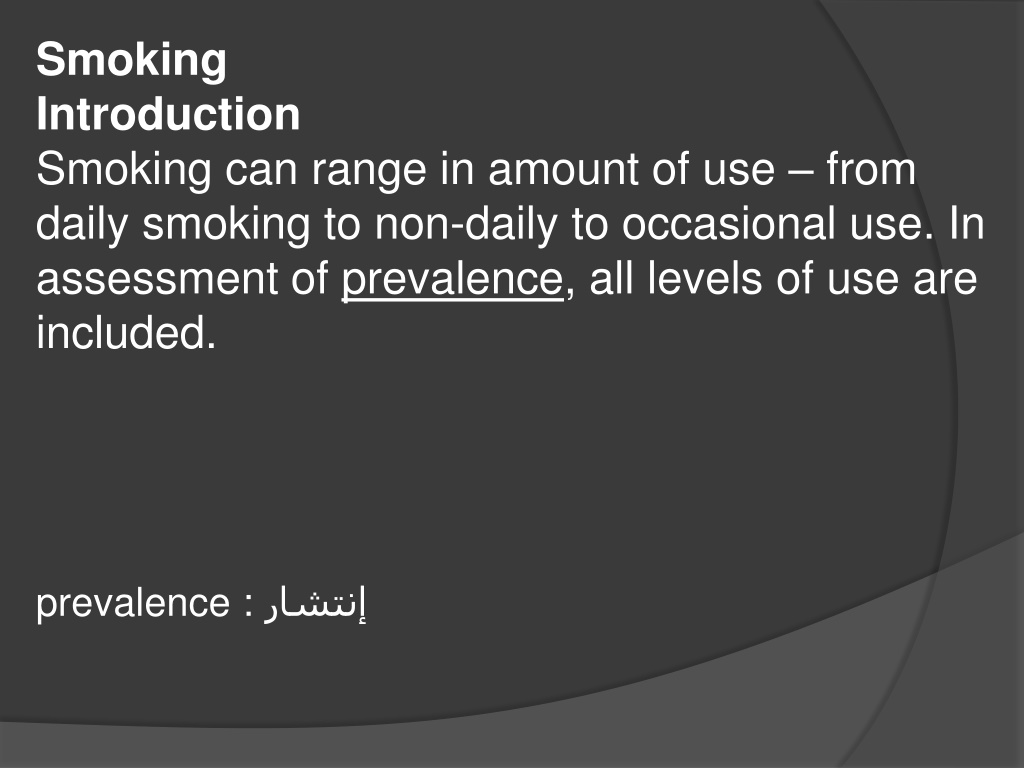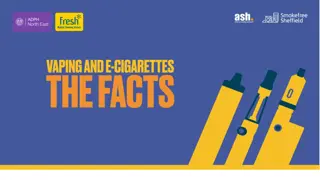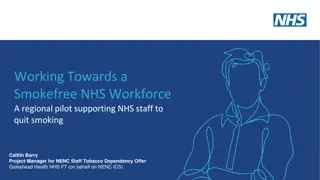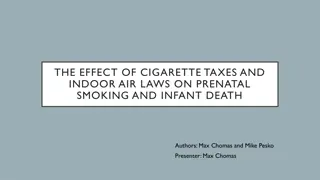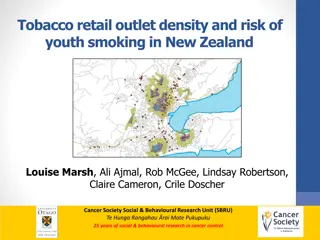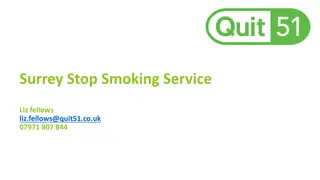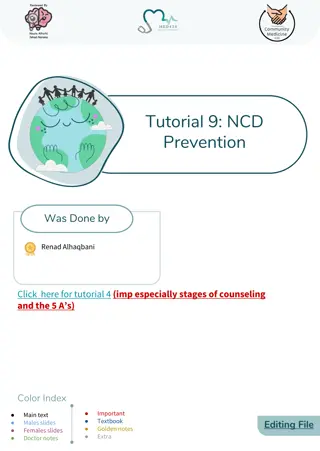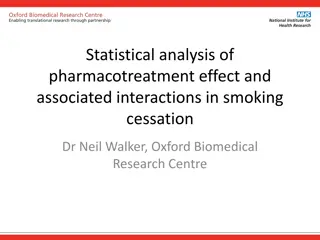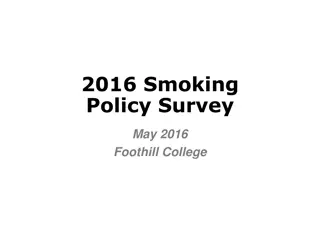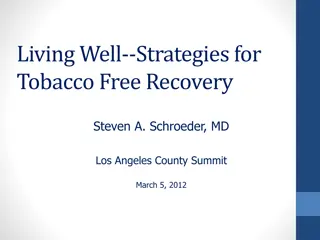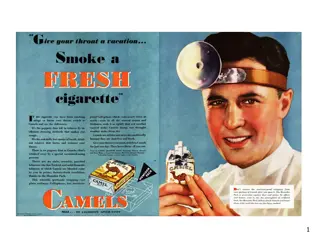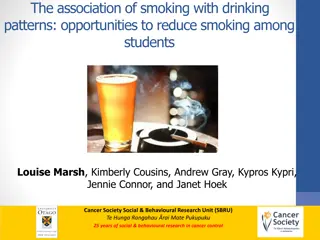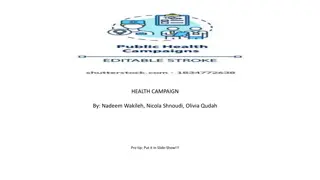The Impact of Smoking on Public Health in the UK
Smoking, ranging from daily to occasional use, remains a significant public health concern in the UK. Despite declining rates, tobacco use still causes thousands of premature deaths annually. Various factors such as socioeconomic status and gender influence smoking prevalence. The Department's tobacco control efforts have led to a decrease in adult smoking rates. Smoking is linked to various health issues, including heart diseases. Awareness and prevention strategies are crucial in combating the adverse effects of smoking on individuals and society.
Download Presentation

Please find below an Image/Link to download the presentation.
The content on the website is provided AS IS for your information and personal use only. It may not be sold, licensed, or shared on other websites without obtaining consent from the author.If you encounter any issues during the download, it is possible that the publisher has removed the file from their server.
You are allowed to download the files provided on this website for personal or commercial use, subject to the condition that they are used lawfully. All files are the property of their respective owners.
The content on the website is provided AS IS for your information and personal use only. It may not be sold, licensed, or shared on other websites without obtaining consent from the author.
E N D
Presentation Transcript
Smoking Introduction Smoking can range in amount of use from daily smoking to non-daily to occasional use. In assessment of prevalence, all levels of use are included. prevalence :
Tobacco use also includes the use of pipes, cigars, chewing tobacco and other smokefree tobacco products such as paan (Betel leaf combined with the areca nut, traditional in South and South East Asia), and snus (used frequently in Sweden). Betel leaf : areca nut: Snus:
Epidemiology Smoking rates have been declining significantly in England since the 1960s. Prevalence peaked in the 30s and has been declining since. Scotland has higher rates than England. More males smoke than females, except for in teenagers, where females have a higher prevalence of smoking. There is a higher prevalence of smoking in lower socio-economic groups; social class V (unskilled working class) has the highest smoking rate. Peaked: Epidemiology:
smoking is rare in Muslim communities, and among Chinese women. There is a high proportion of smoking in some occupations e.g. soldiers. There is a high prevalence in manual workers. There is also a strong association with smoking and high alcohol intake.
Health Effects of Smoking Smoking is known to be the principal avoidable cause of premature deaths in the UK. 106,000 deaths in the UK are caused by smoking every year (87,000 in England). Over 9 million adults in England still smoke. principal :
The Department's tobacco control programme is split into six 'strands', which each contribute to the overall reduction in smoking. Since 1998 adult smoking rates in England have fallen from 28% to 22% in 2006. These are the lowest smoking rates in England on record. strands :
There are many effects of smoking on health, and these include: Heart Diseases Smokers under the age of 40 have five times greater risk of heart attack than non- smokers. Smoking causes about 17% of deaths from heart disease.
Cerebrovascular disease Smoking doubles the risk of stroke Chronic Obstructive Pulmonary Disease (COPD) COPD affects the lungs and respiratory system. Amongst other symptoms, breathing normally is made extremely difficult. A person with COPD will gradually experience a decline in the function of their lungs. Smoking is the main cause of COPD. Between 80 - 90% of all deaths from COPD are due to smoking. Cerebrovascular disease: Obstructive Pulmonary Disease :
Cancer About one third of cancer deaths can be attributable to smoking. People who smoke between 1 to 14 cigarettes a day have eight times the risk of dying from lung cancer compared to non-smokers. Lung cancer is particularly associated with smoking, but also linked are cancers of oesophagus, larynx, bladder, kidney, pancreas, cervix and stomach. oesophagus : larynx : bladder : Cervix:
Emphysema Emphysema is a severe lung disease. Alveoli in the lungs become damaged due to tobacco smoke. Psychological effects of addiction Through addiction to nicotine, a person can develop a psychological, uncontrollable dependence on tobacco. Stopping smoking would cause emotional and/or physical reactions. Emphysema : Alveoli :
Smoking in pregnancy and after birth Smoking while pregnant causes increased risk of miscarriage, low birth weight, and inhibited child development. Smoking by parents following the birth is linked to sudden infant death syndrome, and higher rates of infant respiratory illness. Miscarriage: Inhibited: Syndrome: Respiratory:
Secondhand smoke Secondhand smoke is a mixture of side stream smoke from the burning tip of a cigarette, and mainstream smoke exhaled by a smoker. There is evidence that secondhand smoke has negative health effects, particularly COPD and increased risk of lung cancer. Exhaled: COPD:
Thirdhand smoke There has been recent evidence that babies whose parents smoke are exposed to third hand smoke by touching furniture and other objects in the home. However there is no evidence yet of the health risk this might pose. Levels of tobacco use are determined by cotinine levels in saliva. pose : cotinine : saliva :
Interventions The Department of Health s tobacco control strategy covers 6 strands. These are: Reducing exposure to second hand smoke Smoking cessation Media and education campaigns Reducing availability of tobacco products Reducing tobacco advertising and legislation Tobacco regulation
Increasing the price of cigarettes and tobacco is one method at policy level of decreasing tobacco use, and is a way of reducing the availability of tobacco products. The UK has the most expensive cigarettes in the EU and among the most expensive cigarettes in the world.
This is, in large part, to deter people from smoking. However, smuggling leads to the availability of cheap cigarettes and so helps to maintain high rates of smoking among disadvantaged groups. Deter: smuggling : Disadvantaged:
The UK has a ban on tobacco advertising. Evidence links a ban on tobacco advertising with a decrease in smoking levels. It is estimated that in the long term, the UK advertising ban will lead to a 2.5% decrease in smoking levels. ban :
In addition, in the UK there are regulations on the labeling of packs. Health warnings are printed on tobacco packs and these were introduced in 2003. Misleading terms such as low-tar, mild and light are also prohibited from tobacco packs. Picture warnings will start appearing on cigarette packs from the autumn of 2008, and on other tobacco products from the end of 2009. labeling : Packs: Tar:
The UK is the first country in the EU to require picture warnings on all tobacco products. Research from Canada, where picture warnings have been required for several years, demonstrates that they are highly effective in encouraging people to quit smoking.
Preventing uptake in young people: In October 2007, the age of legal sale of tobacco products was increased from 16 to 18, with the aim of deterring young people from starting to smoke. National Institute for Health and Clinical Excellence (NICE) have produced guidance on preventing the uptake of smoking by children and young people. This guidance focuses on mass-media and point-of-sales measures to prevent the uptake of smoking by children and young people under 18. uptake : Deterring: Guidance:
Campaigns and media: Mass-media interventions use a range of methods to communicate a message at a local or national level. This can include television, radio and newspapers, and leaflets and booklets. leaflets :
The National Health Services (NHS) has had a recent smokefree advertising campaign which highlighted to parents who smoke that children with smoking parents are 3 times more likely to become smokers than those with parents who are non-smokers.
The World No Tobacco Day is on the 31st May each year. It highlights the widespread use of tobacco and its health effects and is a method of encouraging people to stop or not start smoking. In England No Smoking Day is on 12th March each year, and is an important time for campaigners and health promotion workers to encourage people not to smoke.
